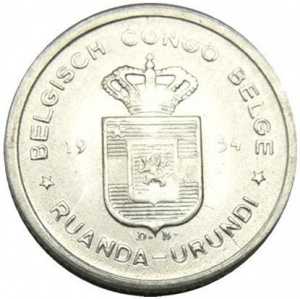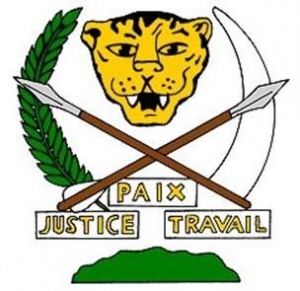National arms of Congo
NATIONAL ARMS OF CONGO
| English | blazon wanted |
Origin/meaning
The current emblem has been adopted on February 18, 2006.
The emblem shows a leopard's head, a spear and a elephant's tusk. These are the traditional symbols of power of the local rulers in the 19th century and appear first in the arms of Congo in 1963.
The Independent State of Congo (1884-1908)
The heraldic history of Congo begins on June 21, 1877, when the African International Association (AIA), created in September 1876 on the initiative of the King of Belgium Leopold II "to open Africa to the civilisation and to abolish the draft of the slaves", chooses as emblem a blue flag with a golden star in the centre. The star symbolised the hope enlightening the African darkness. This flag supposedly was designed by the king himself.
Used by several explorers engaged in the service of Leopold II, who hoisted it on the stations which they install on the Congolese territory, this flag quickly becomes the mark of King Leopold II in central Africa.
The symbolism was adopted again in 1882 by the International Association of Congo (IAC) which had been created in the meantime by the King. At the Congress of Berlin, in February 1885, the IAC becomes the Independent State of Congo (ISC) and Leopold II becomes the sovereign.
On May 29, 1885 the Independent State of Congo was granted its arms, based on the design of the flag.
| The large arms |
The small arms |
| The arms on an 1887 coin |
The arms by Rosenfeld, 1895 |
| The arms on an EFA postcard (+/- 1900) |
The arms on a postcard +/- 1905 |
| The arms by Ruhl +/- 1905-1910 |
The arms in a German album +/- 1910 |
The arms shows the star from the flag of the AIA, the river Congo and as an inescutcheon the arms of the King himself. These were granted to him in 1880 and showed the lion of Belgium, with a small shield of Saxony, for the Sachse-Coburg und Gotha dynasty. The arms also show the supporters and mantling of the Belgian kingdom, and the motto Travail et Progress (Labour and progress).
After the death of King Leopold, his 'private colony' was transformed into the Belgian Congo.
Belgian Congo (1908-1960)
After the transfer of the Independent State of Congo to Belgium, the Belgian law of 18/10/1908 clarified that Belgian Congo could continue to make use of the seal and the flag which had used the Independent State of Congo. The arms thus officially were never modified until the independence of Congo in 1960.
The small shield of Saxony officially remained part of the arms in spite of the fact that the royal house stopped using it and officially disappeared from the royal coat of arms after the 2nd world war. The reason is that this small shield on the lion is the personal mark of Leopold II, and not of Belgium, nor even the dynasty. Even though it was officially still part of the arms, it was also often removed (as can be seen on the coin below).
| The arms on a coin |
The arms on a German cigarette card (1930) |
The arms were either used separately, or used in alliance with the Belgian arms. Under the two shields the two mottos were shown : 'Travail et progrès' (work and progress) for Congo and 'L'Union fait la force' (the union provides strength) for Belgium.
| The arms of Congo and Belgium |
In 1960 the Belgian Congo became independent as Congo(-Kinshasa).
Congo-Kinshasa (1960-1966) and Democratic Republic of Congo (1966-1971)
In 1960 the Belgian Congo became the independent republic of Congo (first as Congo-Léopoldville, later as -Kinshasa). Some months before the date fixed for the Independence of Belgian Congo, a new coat of arms appeared in the title wrapper of the Official Bulletin. It shows a five-pointed star and six smaller stars arranged along the centre one, all yellow on a blue field . The stars symbolize the Republic and the six provinces: Equateur, Leopoldville, Kasai, Katanga, Kivu and Province Orientale.
These arms were used until 1963.
| The arms of 1960 |
In 1963 a new flag was adopted and a shield based on the flag replaced the previous arms. These arms were sometimes used until 1966, but were probably not official.
| The flag-based arms of 1963 |
In 1963 the government also adopted officially a new emblem, which is very similar to the currently used emblem. It could either be used separately, but was also used on a blue shield. In 1964 the emblem was slightly changed again.
| The emblem of 1963 |
The emblem of 1963 on a shield |
| The emblem of 1964 |
The arms on a 1967 coin |
Zaire (1971-1997)
In 1971 the country was renamed Zaire but the emblem was not changed.
Democratic Republic of Congo (1997,-)
In 1997 the emblem was slightly changed, by replacing the motto by a rock. Two years later the country again used an official coat of arms, based on the 1960 version, but now with the stars placed in chief. These arms were used until 2003, when a new version of the old emblem was introduced. These were finally replaced by the current emblem in 2006.
| The emblem of 1997 |
The arms of 1999 |
| The emblem of 2003 |
Contact and Support
Partners:
Your logo here ?
Contact us
© since 1995, Heraldry of the World, Ralf Hartemink 
Index of the site
































